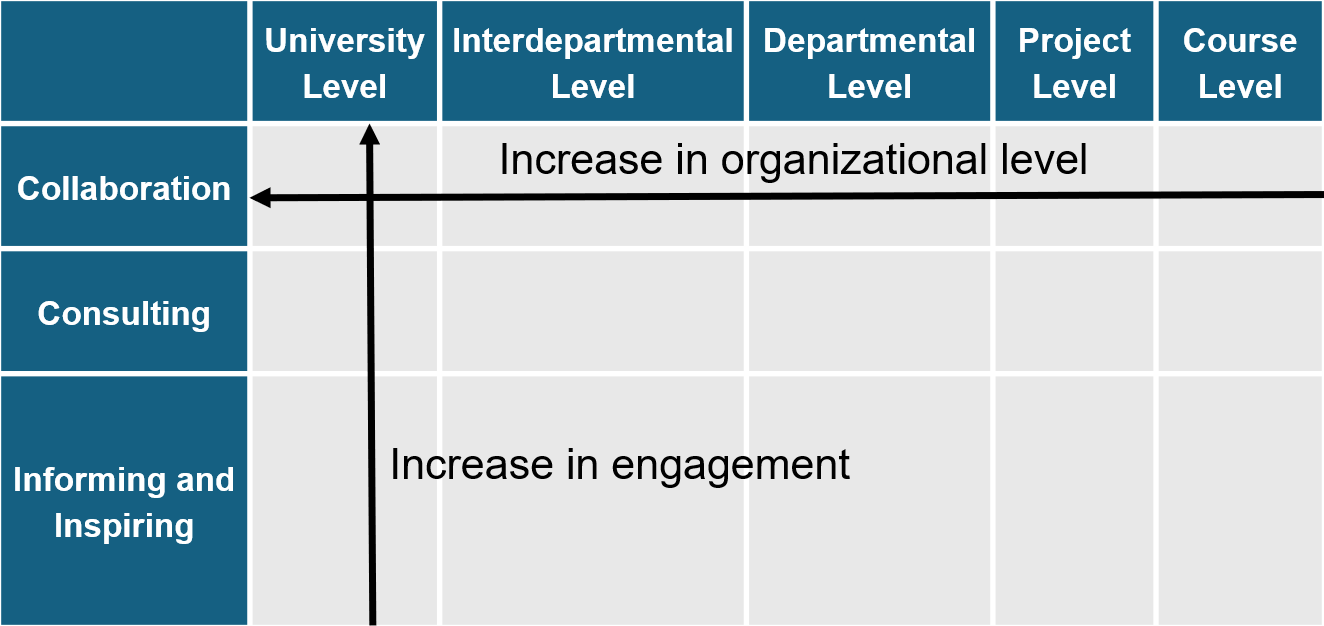A very important factor in characterising the societal impact of transdisciplinary initiatives is the extent to which different academic and non-academic stakeholders are involved in research processes, and which levels of engagement/participation can and should be strategically promoted at ENHANCE universities. This issue has been addressed more broadly in many recent publications, such as challenges around involving non-academic actors
We have researched selected case studies of transdisciplinary sustainable development initiatives that have taken place at ENHANCE universities. To date, the case study database contains information on more than one hundred projects and initiatives. In our research, we followed the non-hierarchical types of engagement developed by the European Science Engagement Association EUSEA, which identifies three circles of participation levels: informing/inspiring, advising and collaborating, all of which are linked to further attributes of engagement. On this basis, we have learned that the initiatives mapped at ENHANCE universities represent a wide range of engagement, depending on the different stakeholder groups involved:
In the scientific field: researchers from one or more disciplines, from different sciences, researchers and coordinators from science management, bachelor/master students, doctoral students, other research institutions
As non-academic/social actors: businesses, industry, administrations, municipalities, civil society organisations and the public
Table 1 shows the dimensions of the initiatives mapped to provide insight into the different levels of engagement (vertical dimension) and the organisational level at which they are institutionalised (horizontal dimension).

In the vertical dimension, the arrow shows the direction of increasing collaboration – from informing and inspiring problem-solving to full involvement and collaboration at every stage of the project's progress. At the Inform and Inspire level, stakeholders are provided with information about the research. This is a one-way communication where researchers share their findings, ideas and insights to raise awareness and interest in the research topic. The aim is to keep stakeholders informed and engaged, and to ensure that they understand the importance of the research and its potential impact. The Consultation level involves a two-way exchange of information where researchers seek feedback, input and advice from stakeholders. This level of engagement is characterised by the opportunity for stakeholders to influence certain aspects of the research. Researchers actively listen to stakeholders' opinions, concerns and suggestions to ensure that the research is more relevant and responsive to the needs and perspectives of those affected. The Collaboration is the highest level of stakeholder engagement, where stakeholders and researchers work together throughout the research process. This level is characterised by shared decision-making, joint problem-solving and co-creation of knowledge. Stakeholders are seen as partners in the research, contributing their expertise, resources and perspectives to achieve common goals.
In the horizontal dimension, the arrow indicates the direction of increasing institutionalisation of the initiative – its generalisation from the level of a course or project team to the whole university. The university level refers to the formal organisational structure within the academic institution and is also the highest level of organisation to be analysed. It includes the different departments, faculties and administrative units and how they work together to achieve common goals. The university level facilitates communication and decision-making between the different parts of the university. Next, the interdepartmental level focuses on collaboration between different academic departments or faculties within the same university. Initiatives at this level include joint research projects, joint teaching efforts or the sharing of research between different departments. Such collaboration promotes the exchange of knowledge between different academic fields. The departmental level focuses on cooperation within individual departments or faculties. Transdisciplinary initiatives at this level involve research projects, the sharing of researchers or teaching activities within the same department. This level of collaboration strengthens the research capacity of the department. The project-based level involves collaboration on specific research projects or initiatives. Researchers from different departments or faculties come together to work towards a common goal. This type of collaboration leads to focused outcomes. The course-based level refers to education, which is an important part of the university's identity and mission. This includes the design and delivery of educational courses for the university's students, either at Bachelor's or Master's level. It often involves students from different educational programmes within the university and external stakeholders.
During the research, we extended the matrix in the area of the organisational (horizontal) level via the non-university level with three sub-levels (Table 2): organisational network, national and international level. However, as we didn't find many transdisciplinary initiatives in ENHANCE universities at this level, we make it the next, developmental stage of our research.

According to our research, both levels of engagement and societal impact are essential aspects of transdisciplinarity that can and should be worked on, as they are crucial for achieving the central objective of the projects, namely continuous sustainable development and societal transformation. Through various interviews and reflections, we have identified effective strategies for achieving this goal and improving the quality of the process and its result, such as promoting interdisciplinary reflection and knowledge transfer on transdisciplinary approaches and challenges. One important strategy is to create a reciprocal and inclusive learning environment, involving the whole University and other interested parties, including external researchers and stakeholders, to encourage collaborative community building. In addition, an informal setting for open discussion of failures and strategies for improving transdisciplinarity has proved valuable. It is also important to strengthen the transdisciplinary research community, transdisciplinary research approaches, and the knowledge base for transdisciplinary research.
ENHANCE materials
Discussion, comparison and analysis of transdisciplinary approaches in ENHANCE partner universities by Kathrin Wieck
Catalogue of joint advisory for supporting transdisciplinary research by Sarah Fowkes and Kathrin Wieck

